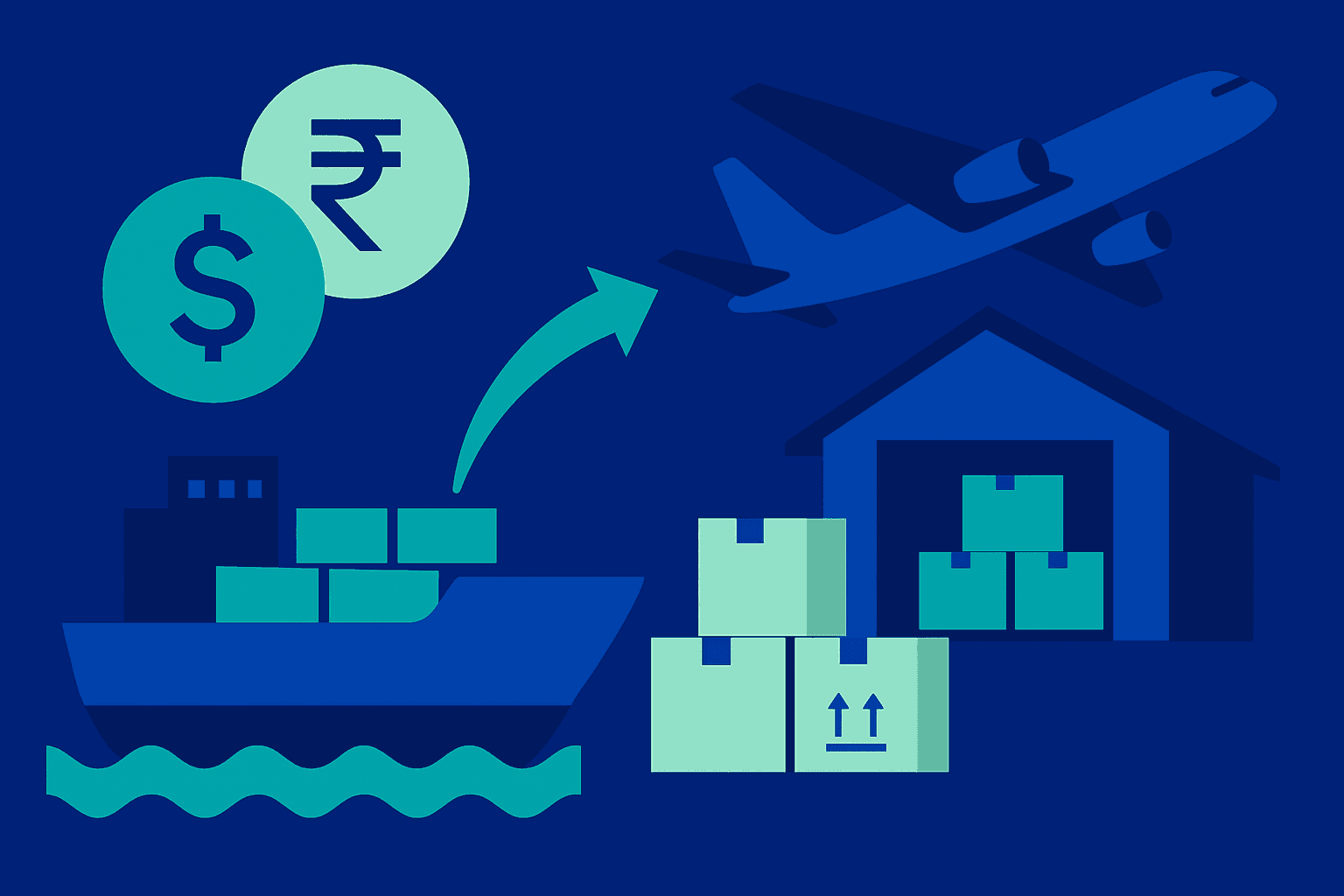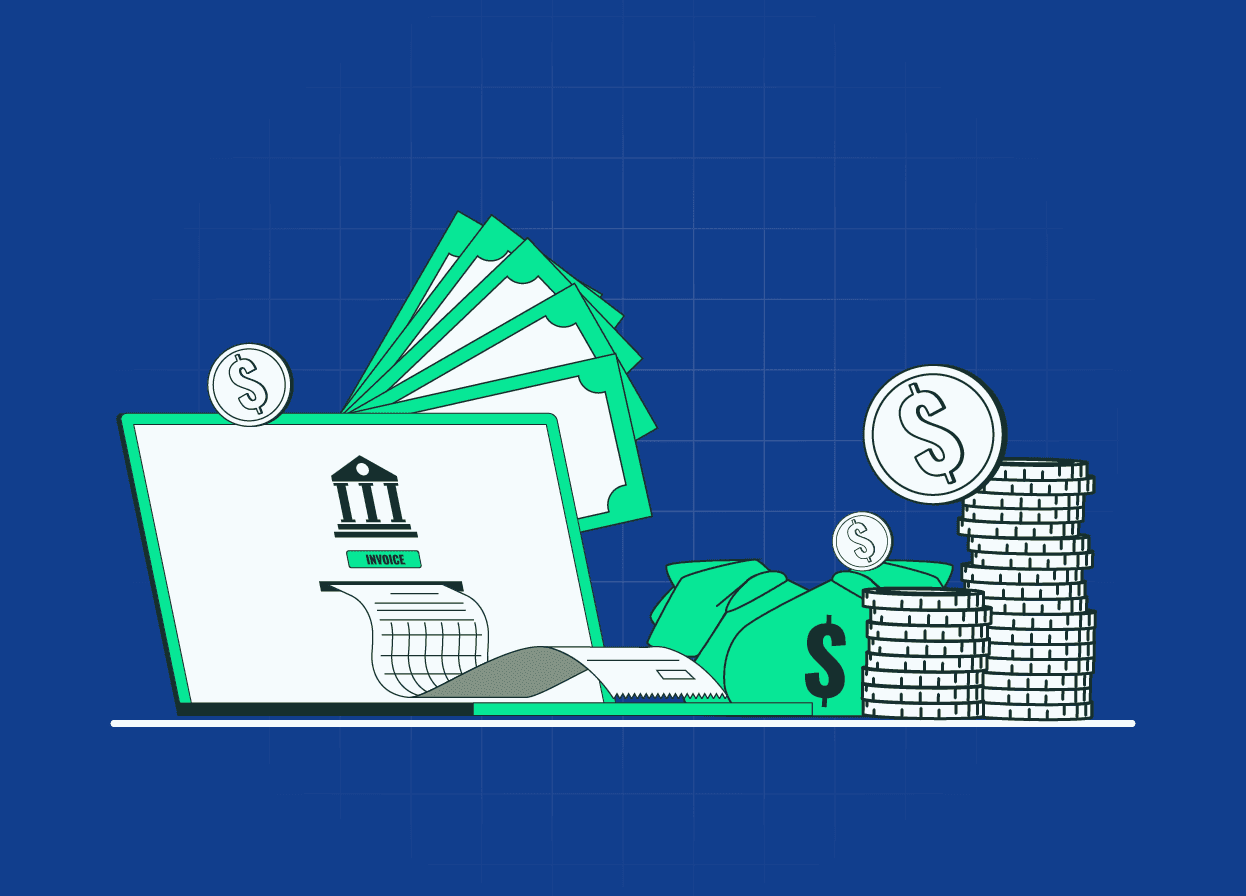Forex Markup Fee: What You Should Know (Updated September 2025)

Updated on: 27th November 2025
TLDR:
- A forex markup fee (foreign transaction fee) is an extra charge of ~1–3% that banks/payment providers add to the exchange rate when converting foreign payments to INR.
- It’s often hidden – you won’t see a line item for it, but it reduces the rate you get and thus the amount you receive.
- These fees significantly impact your earnings: e.g. a 3% markup means losing ₹3,000 per ₹100,000 received. Over multiple transactions, this can total lakhs in lost revenue annually.
- You can avoid forex markup fees by using platforms that offer 0% markup (mid-market exchange rates), by carefully checking exchange rates on your remittances, and by choosing credit cards or accounts with no foreign transaction fees.
- Skydo helps businesses receive international payments with zero forex markup, ensuring you get the full exchange value with no hidden cuts – always.
Ever wondered why the foreign payments you receive are less than expected? The culprit is likely a forex markup fee – a hidden foreign transaction fee charged on currency conversions.
These small percentage fees (usually 1% to 3.5%) can quietly eat into your international earnings. For businesses and freelancers receiving money from abroad, understanding and avoiding foreign exchange markup fees is crucial to protect your income.
As per Economic Times: In FY 2024-25, India received a record US $135.5 billion in foreign remittances, while outward spending by residents touched around US $31.7 billion in FY 2023-24. This means more Indians than ever are dealing in foreign currency. That makes it more important than ever to spot these hidden charges and find ways to eliminate them.
This article will explain what a forex markup fee is, where it’s charged, and how to avoid it. We’ll also compare typical providers and show how avoiding these fees can save you a fortune. (Spoiler: Simply switching to a zero-markup platform could increase your foreign income by 3% or more overnight.)
What is a Forex Markup Fee?
A forex markup fee, also known as a foreign transaction fee or foreign currency markup fee, is an additional charge that banks, credit card providers, and payment processors tack onto the exchange rate when converting currency. Instead of giving you the true mid-market exchange rate (the one you see on Google), they offer a slightly worse rate and keep the difference as their fee.
In simple terms, it’s a hidden currency conversion fee. For example, if the real market rate is 1 USD = ₹83, a bank might apply a 3% markup and actually convert your dollars at ₹80.51 per $1. That difference of ₹2.49 per dollar (3% of 83) is the forex markup fee in action.
Example: You’re a freelancer who earned $10,000 from a U.S. client. Live rate says $1 = ₹83, so you expect ₹830,000. If your bank quietly applies a 3% foreign exchange markup fee, the effective exchange rate becomes ₹80.51 per $1 (3% lower than ₹83). - Your $10,000 converts to only ₹805,100 instead of ₹830,000. You lost ₹24,900 on this single transaction due to the hidden markup.
These seemingly small percentages have a significant impact on large payments. A professional receiving $5,000 monthly would lose ~₹12,450 each month at a 3% markup – that’s nearly ₹150,000 in a year gone to the bank’s profit. A business receiving $100,000 quarterly would see about ₹10 lakh per year siphoned away in markup fees if a ~3% margin is applied.
Why don’t I see this fee on my statement?
Because it’s hidden in the exchange rate, the bank isn’t charging you a separate “fee” line item; instead, they gave you a poorer rate. This lack of transparency is exactly what makes forex markups insidious. Many people only discover the loss when they compare the rate they got to the mid-market rate for that day.
In essence, a forex markup fee means you’re not getting the full value of your hard-earned foreign payment. It’s money left on the table – or rather, handed to the bank.
The Hidden Nature of Forex Markup Fees
Forex markup fees often go unnoticed because providers seldom advertise them openly. Your invoice might say you received $10,000, and your bank account shows the rupee amount – which you might assume was just the going rate. In reality, a cut was taken.
To verify this yourself, check the official advice from your bank for each international payment. In India, banks issue Foreign Inward Remittance Advice (FIRA) for wire transfers, which shows the exchange rate applied. Always compare that rate to the real-time mid-market rate (you can find mid-market rates on Google or XE). The difference is the hidden markup. For instance, if your FIRA shows “1 USD = ₹80.00” but the market rate was ₹81.50, then ~₹1.50 is the markup fee per dollar (~1.8%).
Many new businesses and freelancers only realise they’ve been paying these fees after doing this comparison , often after losing substantial sums on multiple transactions. Indian banks typically apply a markup of 1.5% to 3.5% on foreign currency conversions, which can dramatically reduce your net earnings.
(It’s important to note this is separate from any explicit wire transfer fee. Even if a bank says “$10 wire fee”, they could still be taking 2-3% in the conversion rate.)
Bottom line: Always check the exchange rate you were given vs. the true rate. That hidden gap is money that could have been yours.
Where is the Forex Markup Fee Levied?
Forex markup fees appear in a variety of scenarios whenever currency conversion is involved. Knowing where these fees lurk helps you anticipate and avoid potential losses. The main places you’ll encounter forex markups include:
- Credit Card Transactions (Purchases in Foreign Currency): If you swipe your Indian credit or debit card abroad or on an international website, the bank will not use the exact Visa/Mastercard rate – they’ll add their markup (typically 2%–3.5% on top of the exchange rate).
For example, buying a €100 item on your card might cost you ₹9,350 instead of ₹9,100, because of ~2.5% in forex markup and fees. This is often called a foreign transaction fee on credit cards. On Indian cards, 3.5% + GST is a common markup fee for foreign currency spends. It applies when: you conduct retail transactions abroad, shop online in a foreign currency, withdraw cash in a foreign country, or even make a payment in INR that’s routed through a foreign bank (per some credit card terms). In all these cases, your card issuer skims a percentage by giving you a worse exchange rate.
Example: A freelance graphic designer in Mumbai charges a US client ₹83,000 (equivalent to $1,000 at ₹83/USD). The client pays by credit card. By the time the payment is processed and hits the designer’s account, only about ₹81,000 is received. Why? The payment processor or bank applied a ~2.4% markup fee during conversion, effectively using a rate of ~₹81 instead of ₹83. The ₹2,000 difference went to the processor as their forex fee cut.
- Bank Wire Transfers & Inward Remittances: When a client sends you money from abroad directly to your bank (SWIFT transfer, wire, etc.), your bank will convert that USD/EUR into INR upon receipt, and they will almost always apply a markup. Every time a bank converts currency for you, a markup fee is likely.
For example, an IT consultant receiving a €5,000 wire might expect ₹455,000 at a ₹91 rate, but if the bank uses ₹89.18 (2% markup), they’d get only ~₹445,900 – about ₹9,100 less than expected. Again, this fee is hidden; your statement may just show “Amount credited: ₹445,900” without any breakdown. It’s on you to realise a markup was taken. Indian banks, in particular, are known to take around 2–3% on such remittances as their currency conversion margin.
Important: This happens even on platforms like SWIFT/NEFT transfers. You might also encounter fixed charges (like $15-$30 SWIFT intermediary bank fees), but the conversion markup can dwarf those. Always ask your bank what exchange rate they applied. Some banks will disclose if pressed, others might not – which is a sign the markup is significant.
- Online Payment Gateways: Popular platforms that facilitate international payments often have two layers of fees: an explicit transaction fee and an exchange rate markup. For instance, PayPal levies. 4.4% transaction fee plus a 4% currency conversion fee over the mid-market rate. Payoneer and Stripe similarly have markup fees (~3% and ~2% respectively).
Example: An e-commerce seller receives $2,000 via a payment platform. There might be a 5% platform fee (~$100), leaving $1,900 to convert. For currency conversion, instead of ₹83, the platform uses ₹81.34 (a 2% markup). That gives ₹154,546 instead of the ₹166,000 they should have received — a loss of about ₹11,450 due to the fees and markup combined.
Some platforms are more upfront about this than others. PayPal, for example, explicitly mentions its currency conversion charges. Others, like Wise, show you the mid-market rate and their fee separately (Wise typically has no markup, just a transparent fee). Knowing where these fees occur allows you to make informed choices – whether that’s picking a better payment method or negotiating terms with clients (e.g., billing in INR vs USD, or choosing which side covers fees).
Pro Tip: If you’re receiving international payments regularly, consider opening a USD/EUR receiving account with platforms like Skydo that offer live forex rate without any markup.
Forex Markup Fee: Skydo Vs Other Platforms
When choosing how to receive international payments, it’s critical to compare the exchange rates and fees of each option. A provider’s forex markup can make a huge difference in how much money actually lands in your account. Here’s a quick comparison:
| Platform | Forex markup fee | Example |
| Skydo | 0% (No forex markup) – uses live mid-market rate | ₹83 per $1 (if market rate is ₹83) – No loss. |
| Traditional Banks (India) | 1% – 3% markup on the rate | ~₹80.5–82 per $1 for a market rate of ₹83. Lose ₹1–₹2.5 per $1 (hidden). |
| PayPal | ~4% markup on currency conversion (in addition to transaction fees) | ~₹79.7 per $1 (if market is ₹83). Lose ~₹3.3 per $1. |
| Payoneer | ~3% markup on conversion (typical) | ~₹80.5 per $1 (for market ₹83).Lose ~₹2.5 per $1. |
| Wise (formerly TransferWise) | 0% markup on rate (uses true mid-market) – transparent fee charged separately | ₹83 per $1 (market rate) – No loss in rate |
| Stripe | ~2% markup on conversion | ~₹81.3 per $1 (for ₹83 market). Lose ~₹1.7 per $1. |
(Rates and fees are illustrative; actual figures may vary. “Lose per $1” means how much value is lost versus the mid-market rate.)
As the table shows, Skydo and Wise offer zero markup, meaning you get the real exchange rate. Banks and platforms like PayPal apply significantly higher markups, reducing the INR amount you receive.
For a large payment, the difference is stark. Receiving $7,000: Skydo (0% markup) would net you full conversion (₹7,000×rate), whereas a bank at 1.2% markup might give ~₹5,98,869 – you’d lose around ₹7k; PayPal at ~8.7% total fees might give only ₹ 5,53,272 (a huge loss).
If saving money on international payments matters to you (and it should!), opting for a platform with live exchange rates and no markup is the way to go. 3-4% may not sound like much, but it can be the difference between turning a profit or not on an international deal, or the equivalent of an extra month’s salary over a year.
Up next, let’s discuss concrete steps you can take to minimise or eliminate forex markup fees on your incoming payments.
How to Avoid Forex Markup Fees
Thankfully, forex markup fees are not a fixed cost of doing business – they can be avoided or at least minimised. Here are strategies to ensure you keep more of your hard-earned money instead of giving it away in hidden conversion charges:
- Always Ask About the Exchange Rate (and Markup) Upfront: Before you choose a bank or service to receive foreign payments, inquire about their forex rate policy. Don’t be shy – ask your bank: “What exchange rate will you apply to an incoming USD payment? Do you add a markup fee? How much?” Many bank representatives will give vague answers, but push for clarity or a written statement. If they say “we use the card rate” or “as per RBI rate” – that often already includes their markup. Request a specific markup percentage over mid-market. The key is to make them spell it out. When you have that, you can compare it to others. For example, if Bank A says “2% markup over interbank rate” and a fintech says “0.5% fee or mid-market rate”, you know the fintech will give you more INR for the same dollars.
- Compare with Mid-Market Rates in Real Time: When a payment arrives, check the mid-market rate (Google, XE, etc.) at that moment. Then compare to what you got. If there’s a big gap, now you have evidence. Over time, tracking this helps you quantify how much you’re losing to forex fees. If you notice one provider consistently giving a poor rate, you might switch to a better one. Some platforms like Wise even have calculators to show what the mid-market rate vs their rate would yield; use these tools to stay informed.
- Check Your FIRA (Foreign Inward Remittance Advice) or Bank Statement Details: As mentioned, the FIRA document for each transaction shows the exact rate applied, the original amount, and the final credit. Always review this. It’s the only place you might see clues of fees. If your bank doesn’t automatically give you a FIRA, request it. Keeping these documents and calculating the difference each time will let you accumulate proof of how much you’re paying in hidden fees. This can even be used as leverage to negotiate with your bank if you have large volumes (e.g., “We plan to route $1 million/year through you, but we need a better conversion rate, otherwise we’ll use X platform.”).
- Use Platforms that Offer Live Mid-Market Rates: Modern fintech solutions are your friend here. Services like Skydo (for businesses), Wise, Karbon, etc., pride themselves on transparency. They give you either the exact market rate or very close to it, and charge a separate fee if needed. For example, Wise shows you the mid-market rate and its fee (no hidden markup), and Skydo offers 0% forex markup – the rate you see is the rate you get. By separating conversion from fees, these platforms ensure you don’t lose money on the exchange rate. Whenever possible, choose such a platform to receive payments. The difference can be dramatic: a traditional bank might give you ₹8,13,400 for $10k (as we saw), whereas a no-markup service would give ₹8,30,000, meaning you keep that extra ₹16,600.
- Time Your Conversions (if using EEFC account): If you have the ability to hold foreign currency (say you have a USD account or wallet), you can convert to INR when rates are favourable and possibly in larger chunks. This doesn’t remove the markup fee unless you convert via a no-markup provider, but it can help you avoid converting at a bad rate day. More advanced: some providers allow you to set rate alerts or auto-conversions when the rate hits a certain point. While this is more about beating exchange rate fluctuations than the provider’s markup, it’s part of optimising forex conversion.
- Negotiate with Your Bank (for High Volumes): If you’re a business bringing in substantial foreign revenue, sometimes banks will negotiate the forex rate or offer a preferential rate tier. For example, businesses transacting millions may get a 1% markup instead of 3%. It never hurts to ask, especially if you have multiple banking options. Let them know you’re considering alternatives (cite that others offer mid-market or low fees). They may not match 0%, but even securing a 1% markup instead of 3% will save a lot. (That said, for most small businesses, it may be more effective to just switch to a fintech provider where you don’t have to negotiate each time.)
- Avoid Unnecessary Conversions: This is more about strategy – if possible, keep funds in foreign currency or spend them in foreign currency to avoid double conversion. For instance, if you receive USD and you also have overseas expenses, see if you can pay those directly from your USD balance. Every conversion in and out could incur fees each way. Similarly, if you’re billing a client, you might quote in INR to have them bear the conversion (though they might then negotiate a lower amount). The key is to minimise how many times money changes currency.
By taking these steps, you can save literally lakhs of rupees every year that would otherwise be lost to markup fees. It requires a bit of vigilance and possibly switching to better services, but the payoff is huge. Remember, every percentage point saved on forex conversion is a direct addition to your profit margin.
What are Forex Markup fees?
They are additional charges (usually 1%–3.5%) hidden in the exchange rate when converting one currency to another. Instead of charging a separate fee, banks and payment providers often give you a poorer exchange rate and keep the difference as their profit. It’s essentially a foreign transaction fee taken by inflating the rate. For example, if the true rate is 1 USD = ₹83, a 2% markup means you get a rate of about ₹81.34 – the ₹1.66 difference per dollar (2%) is the markup fee you’re paying without realising.
How do I avoid Markup fees in Forex?
Is the Markup fee refundable?
Is forex markup fee the same as exchange rate?
What is a markup fee in credit card transactions?












